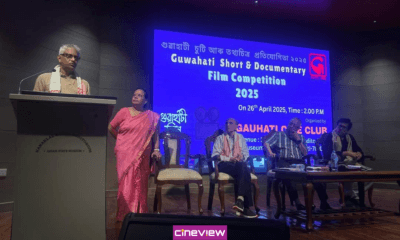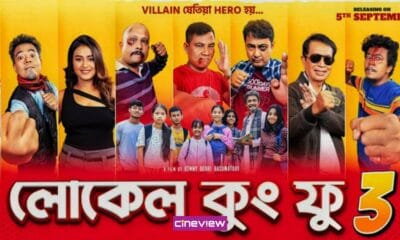Film Reviews
The Promise and Pitfalls of Ashwathama Hoto Iti Gojo
The series “Ashwathama Hoto Iti Gojo” tries to build a suspenseful narrative, while the effort is evident, it doesn’t quite manage to leave a lasting impact.

OTT has recently been trying to take a concrete shape in Assam, with ReelDrama producing web series that show promising potential. It is broadening the way we see cinema and offering the audience of Assam a taste of this new pie. But what if that pie is undercooked? Will it still be served simply because it’s new and unfamiliar to the audience? Or will it be refined before being served? Unfortunately, the former is where much of the recent content lies.
Recently, ReelDrama released a series titled Ashwathama Hoto Iti Gojo, directed by Tanuj Nath, which can be placed under that “undercooked pie.” The series tries to build a suspenseful narrative, while the effort is evident; it doesn’t quite manage to leave a lasting impact.
Though the lead characters are written with nuance and their backstories reflect the writers’ effort, it’s the actors, whether it’s Tapan Das, Himanshu Prasad Das, Mintu Barua, Seema Boruah, Jintu Kumar Kashyap, or the recently talked-about Bondip Sarma, who make the series worth watching. Their screen presence is a treat. However, the series raises a few concerns that need to be addressed. While this piece may read like a review, the issues it touches upon also reflect larger problems within the Assamese film industry and point toward what could be done better.
One of the first things I noticed while watching this series, and recent Assamese films, is how severely they lack in depicting crowd scenes. Since the industry is not organized, we often see crowds gathered from nearby villages who are not trained, which ruins scenes where their presence is essential. But what’s the solution? Commercializing crowd management is likely the most effective approach, but can this budding industry afford it? Technological advancements such as VFX crowd replication, green screen compositing, stock footage integration, or AI-based tools could help, but they also come at a cost.
In that case, perhaps filmmakers need to think of stories that can be told without large crowds. Whichever way one chooses, there is an urgent need for the industry to seriously dwell on this issue. Otherwise, crowd scenes will continue to hamper our storytelling.
For instance, in this series, there are moments where the crowd smiles during serious scenes. In one scene, an actor tells the crowd to sit, but they are already seated. Is that the fault of the crowd, or the actor who lacked a sense of timing, or the director who allowed it to happen on screen?
Simultaneously, a few actors seem to perform in anticipation. Since their scenes are choreographed in advance, they lack a natural flow, and the anticipation of what will happen next is often visible in their expressions or actions. It’s not just the actors; the background music also feels out of sync with the visuals, as if the BGM too is anticipating. For instance, in the scene where Seema Boruah’s character lights a cigarette from the police officer’s, the suspenseful music begins before she even appears on screen, which felt jarring.
Cinematically, Nagen Bashya did an interesting work, and the visuals went well with the theme. But the abrupt focus shifts and oddly placed drone shots point towards a lack of coordination between the director and cinematographer. The drone shots appear in moments where they don’t seem necessary. It ends up breaking the flow instead of adding anything, which makes you question if the director had a clear plan for them.
I also didn’t see much effort from the director to keep the audience hooked. In a crime or thriller, you expect suspense at the end of each episode, something that pulls you to the next. But Nath doesn’t quite manage that; a tighter script might have helped.
The climax, where Harinarayan’s character confesses, is so precipitously written that it completely put me off. The conflict is resolved with just a voice recording, and the villagers accept it without question(?) It feels like the writers took a lazy way out of the confusing mess they created. Sub-plots they used throughout the series, like the protests against Harinarayan or the journalist exposing Raghunath’s role in the kidnapping, lead nowhere.
The series heavily leans on Tapan Das’s character, Ashwathama. While it might sound justified, his character doesn’t actually push the story forward. I feel stories rarely work when they’re built just around a star cast. His complex dialogues could have been made simpler. The director could have focused more on developing existing characters. But the overemphasis on Das’ flattens other characters and leaves the story feeling a bit scattered.
The worry isn’t just about Ashwathama Hoto Iti Gojo going off track, but about how our stories need a tighter hold on the audience in a world of shrinking screens and endless choices.

 Film Reviews10 months ago
Film Reviews10 months agoSundarpur Chaos or Chaos in Director’s Vision

 Film Reviews10 months ago
Film Reviews10 months agoJoy Hanu Man: The Hero Amongst Us

 Film Reviews1 year ago
Film Reviews1 year agoBidurbhai’s Shocking Caricature of Queers: Painful but Not Surprising

 Film Reviews12 months ago
Film Reviews12 months agoLocal Kung Fu 3: Is Assamese Comedy Evolving?

 Film Reviews1 year ago
Film Reviews1 year agoBasumatary’s Jiya is a Beacon of Hope for Assamese Cinema

 Film Reviews11 months ago
Film Reviews11 months agoFor Assamese cinema to flourish, movies like Sikaar are necessary

 Film Reviews11 months ago
Film Reviews11 months agoBhoot Jolokiya: Just like the chili, the movie too lingers long after it’s over

 Film Reviews8 months ago
Film Reviews8 months agoI Want to Talk: It’ll Grow on You, Slowly but Surely























